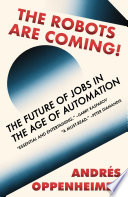

The book begins by discussing the rapid advancement of automation technologies and their implications for various industries. It highlights how robots and AI systems are increasingly taking over tasks traditionally performed by humans. This shift is not only limited to manufacturing but extends to sectors such as healthcare, retail, and transportation. The author provides examples of companies that have successfully integrated automation into their operations, leading to increased efficiency and reduced costs. However, this rise of automation also raises concerns about job displacement and the need for workers to adapt to a changing job landscape. The author emphasizes the importance of preparing the workforce for these changes through education and reskilling initiatives.
Continue readingA significant portion of the book is dedicated to exploring the impact of automation on employment. The author examines the types of jobs that are most at risk of being automated and those that are likely to remain secure. Jobs that involve repetitive tasks or manual labor are identified as particularly vulnerable, while roles that require creativity, emotional intelligence, and complex problem-solving are more likely to endure. The book argues that while automation may lead to job losses in certain sectors, it also creates opportunities for new jobs in technology, maintenance, and oversight of automated systems. The author advocates for a proactive approach to workforce development, encouraging individuals to seek training in fields that are growing as a result of automation.
Continue readingThe book delves into the specific technologies driving the automation revolution, with a particular focus on artificial intelligence (AI) and machine learning. The author explains how these technologies enable machines to learn from data and improve their performance over time. This capability has led to significant advancements in areas such as natural language processing, computer vision, and predictive analytics. The author discusses real-world applications of AI, from chatbots in customer service to autonomous vehicles. By illustrating the practical uses of AI, the book helps readers understand its potential to transform industries and improve efficiency. However, the author also cautions about the ethical implications of AI, including bias in algorithms and the need for responsible AI development.
Continue readingThe author emphasizes that automation presents unique opportunities for innovation and entrepreneurship. As traditional business models are disrupted by new technologies, there is a growing demand for entrepreneurs who can identify and capitalize on these changes. The book showcases case studies of startups that have successfully leveraged automation to create new products and services. The author encourages aspiring entrepreneurs to embrace automation as a tool for enhancing their business operations and scaling their ventures. Additionally, the book discusses the importance of fostering a culture of innovation within organizations to remain competitive in an automated world.
Continue readingA central theme of the book is the future of work in an increasingly automated world. The author explores how workplaces are evolving in response to automation, including flexible work arrangements and the rise of remote work. The book argues that companies must adapt their organizational structures and management practices to accommodate a workforce that may include both humans and machines. The author also discusses the importance of collaboration between humans and robots, emphasizing that the most successful organizations will be those that can effectively leverage the strengths of both. The book concludes with a call to action for businesses to rethink their approach to workforce management in light of these changes.
Continue readingThe book addresses the ethical considerations surrounding automation and its societal impact. The author raises questions about the implications of widespread job displacement and the responsibilities of companies and governments to support affected workers. The book advocates for policies that promote social safety nets and retraining programs to help workers transition to new roles. Additionally, the author discusses the potential for automation to exacerbate existing inequalities and stresses the need for inclusive approaches to technological advancement. By highlighting these ethical dilemmas, the book encourages readers to think critically about the broader consequences of automation on society.
Continue readingIn the final sections of the book, the author provides practical advice for individuals and organizations on how to prepare for an automated future. This includes embracing lifelong learning, developing skills that complement automation, and fostering adaptability. The book also emphasizes the importance of staying informed about technological trends and being proactive in seeking out opportunities for growth. For organizations, the author suggests investing in employee development and creating an environment that encourages innovation and experimentation. By equipping themselves with the right tools and mindset, both individuals and businesses can thrive in a landscape increasingly shaped by automation.
Continue reading